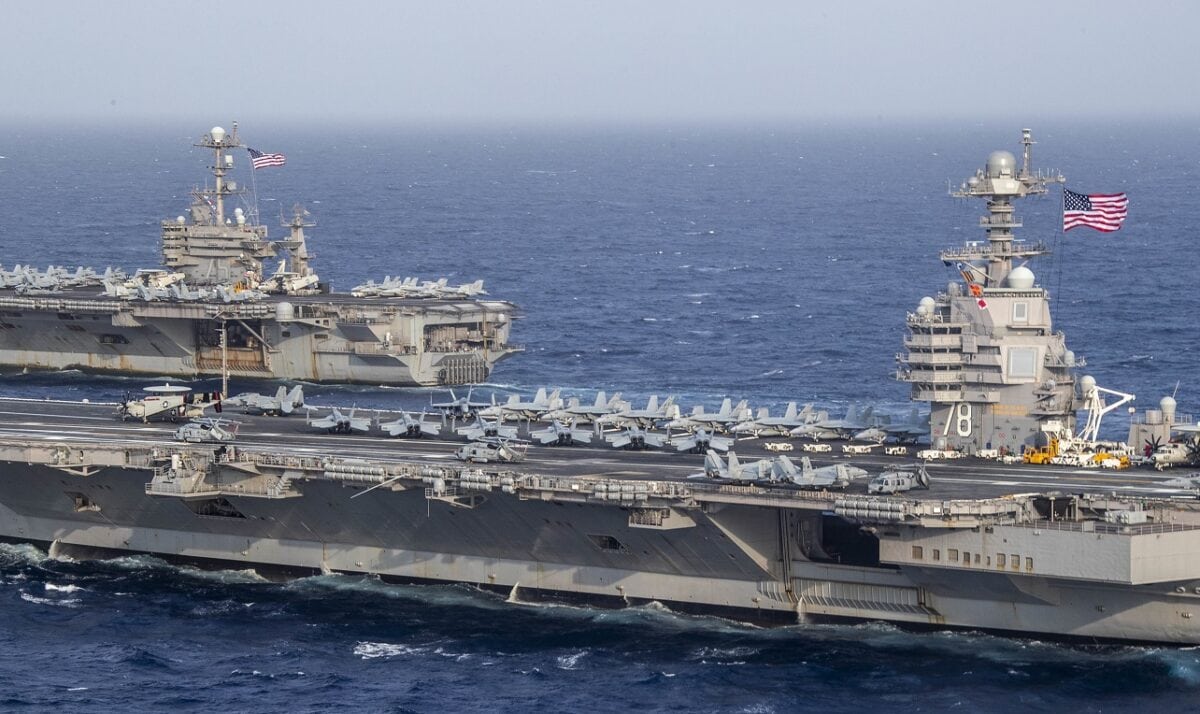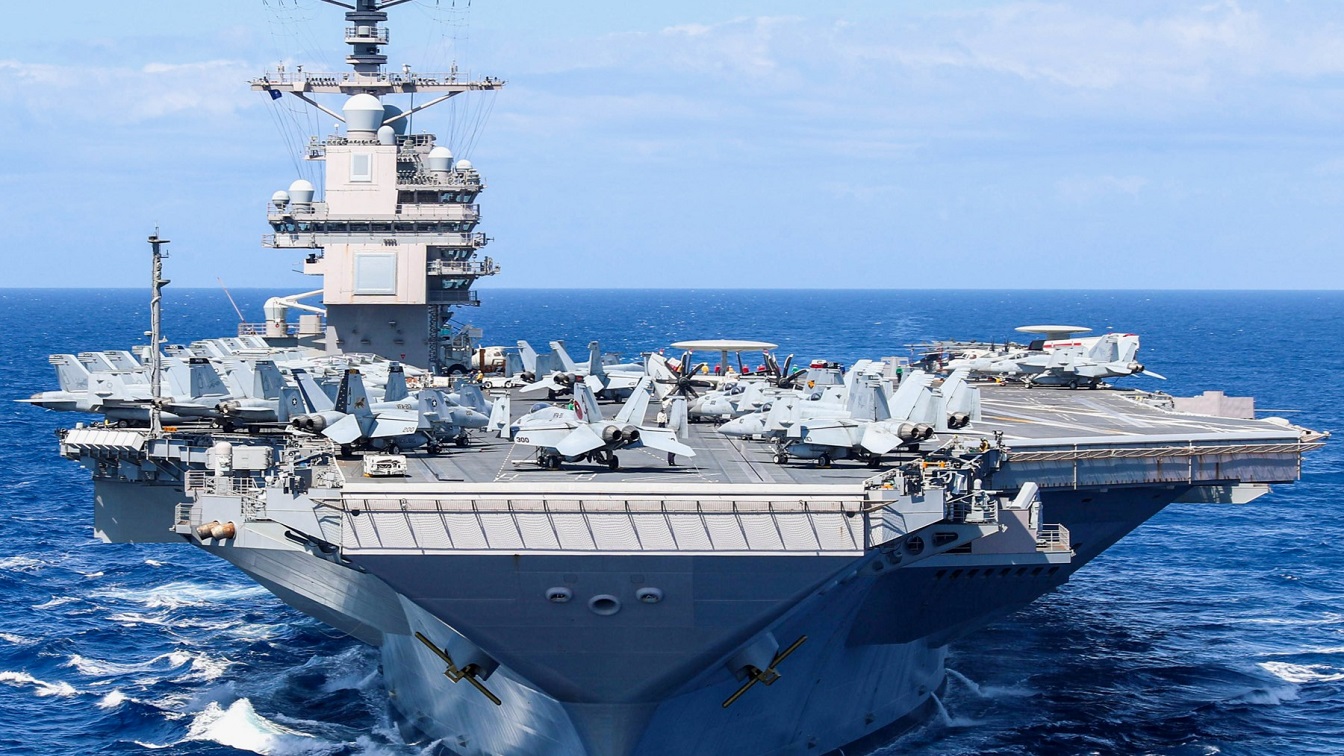Aircraft Carriers obsolete? The U.S. Navy has placed billions of taxpayer dollars into building more and more aircraft carriers. The theory is that these carriers are the ultimate form of power projection short of nuclear weapons. But is the age of the aircraft carrier over? Should the navy keep building new Ford-class carriers, for example?
Just recently, it was announced that the United States Navy’s newest (and largest) aircraft carrier, USS Gerald R. Ford (CVN-78) would take part in a multi-national exercise this fall. The lead vessel of a new class of nuclear-powered supercarriers will also have a “partial air wing” when she finally sets sail.
Though the aircraft carrier was formally commissioned into the United States Navy on July 22, 2017, she has yet to make her maiden deployment. A report from the Government Accountability Office in mid-2020 (updated this summer) warned that CVN-78 was facing a number of significant problems, including the operation of weapons elevators, as well as with clogged toilet system that need to be flushed out regularly. A subsequent Department of Defense (DoD) report from last year also found that ship was not combat-ready due to ongoing issues with its Electromagnetic Aircraft Launch System (EMALS).
Such teething problems are always common with new technology, and it should be added that the vessel underwent an 18-month period of tests and trials, where she spent almost half of that time at sea. Moreover, the ship also underwent four months of shock trials that were meant to showcase her superior design – taking just 20 percent of the damage that USS Theodore Roosevelt (CVN-71) sustained in her shock trials in 1987.
The Latest or the Last Navy Aircraft Carriers?
CVN-78 is the latest carrier set to enter service with the United States Navy, while USS John F. Kennedy (CVN-79) is currently on track to be commissioned in 2024. As USS Gerald R. Ford has replaced the former USS Enterprise (CVN-65) – the world’s first nuclear-powered carrier – CVN-79 will replace USS Nimitz (CVN-68), the lead vessel of the U.S. Navy’s class of nuclear-powered supercarriers.
The current plan calls for Ford-class aircraft carriers to then replace the Nimitz-class flattops on a one-for-one basis over the next four decades. It was just last week that Huntington Ingalls Industries (HII) division Newport News Shipbuilding announced that it will hold a ceremonial keel-laying for the third Gerald R Ford-class aircraft carrier, the future USS Enterprise (CVN-80).
Scheduled to be held on August 27, it will officially begin the construction of the ninth U.S. Navy vessel to bear the name Enterprise. The first steel-cutting ceremony for CVN-80 was held in 2017. In addition, the future Enterprise has become the first aircraft carrier to be designed and built digitally. That has included the use of laser scanning and augmented reality (AR), which has allowed for the transition from “traditional two-dimensional paper-based instructions to digital formats,” The Defense Post reported.
The next carrier scheduled is the future USS Doris Miller (CVN-81), which is expected to be laid down in January 2026 with plans for her to be launched by the end of the decade with commissioning in the early 2030s.
Given that it could be into the 2060s before USS George H.W. Bush (CVN-77) – which was only commissioned in 2009 – is finally retired, it is difficult to suggest what carrier modifications might come following the Ford-class. However, it is likely that that the subsequent flattops of this current class will be significantly modified, likely to operate with the F/A-XX sixth-generation aircraft currently in development, as well as autonomous/unmanned aircraft.

The Ford-class aircraft carrier USS Gerald R. Ford (CVN 78) and the Nimitz-class aircraft carrier USS Harry S. Truman (CVN 75) transit the Atlantic Ocean June 4, 2020, marking the first time a Ford-class and a Nimitz-class aircraft carrier operated together underway. Ford is underway conducting integrated air wing operations, and the Harry S. Truman Carrier Strike Group remains at sea in the Atlantic as a certified carrier strike group force ready for tasking in order to protect the crew from the risks posed by COVID-19, following their successful deployment to the U.S. 5th and 6th Fleet areas of operation. (U.S. Navy photo by Mass Communication Specialist Seaman Riley McDowell)
Yet, it is also just as likely that the United States Navy will never actually replace each of its Nimitz-class carriers and instead could seek to develop smaller warships that could still do the job. Currently, the Navy is spending $1.5 billion just to scrap CVN-65, a job that could take upwards of 15 years. While it is likely that each subsequent nuclear-powered carrier will see the costs come down, it is also possible that the Pentagon will see the error of its ways in investing in such massive warships that could be easily destroyed by more advanced missiles.
Airpower essentially ended the reign of the battleship, so it is conceivable that missiles will do the same for the massive aircraft carriers. The four Iowa-class warships were the final battle wagons ever built for the U.S. Navy, and a safe bet would suggest the Ford-class is the final supercarrier as well.
Expert Biography: A Senior Editor for 1945, Peter Suciu is a Michigan-based writer who has contributed to more than four dozen magazines, newspapers, and websites with over 3,000 published pieces over a twenty-year career in journalism. He regularly writes about military hardware, firearms history, cybersecurity, and international affairs. Peter is also a Contributing Writer for Forbes.

